YAMAHA XSR 900 2022 Workshop Manual
Manufacturer: YAMAHA, Model Year: 2022, Model line: XSR 900, Model: YAMAHA XSR 900 2022Pages: 114, PDF Size: 4.36 MB
Page 51 of 114
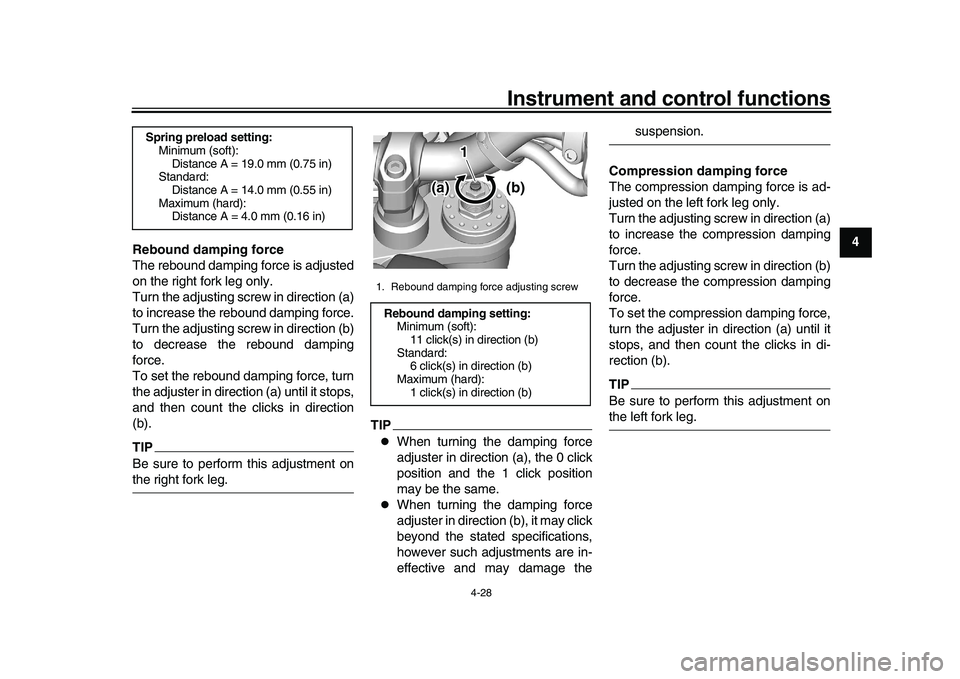
Instrument and control functions
4-28
1
2
345
6
7
8
9
10
11
12
13
Rebound damping force
The rebound damping force is adjusted
on the right fork leg only.
Turn the adjusting screw in direction (a)
to increase the rebound damping force.
Turn the adjusting screw in direction (b)
to decrease the rebound damping
force.
To set the rebound damping force, turn
the adjuster in direction (a) until it stops,
and then count the clicks in direction
(b).
TIPBe sure to perform this adjustment onthe right fork leg.
TIP
When turning the damping force
adjuster in direction (a), the 0 click
position and the 1 click position
may be the same.
When turning the damping force
adjuster in direction (b), it may click
beyond the stated specifications,
however such adjustments are in-
effective and may damage the
suspension.
Compression damping force
The compression damping force is ad-
justed on the left fork leg only.
Turn the adjusting screw in direction (a)
to increase the compression damping
force.
Turn the adjusting screw in direction (b)
to decrease the compression damping
force.
To set the compression damping force,
turn the adjuster in direction (a) until it
stops, and then count the clicks in di-
rection (b).
TIPBe sure to perform this adjustment onthe left fork leg.
Spring preload setting: Minimum (soft): Distance A = 19.0 mm (0.75 in)
Standard:
Distance A = 14.0 mm (0.55 in)
Maximum (hard): Distance A = 4.0 mm (0.16 in)
1. Rebound damping force adjusting screwRebound damping setting:Minimum (soft):
11 click(s) in direction (b)
Standard: 6 click(s) in direction (b)
Maximum (hard): 1 click(s) in direction (b)
(b)
(a)
111
BEA-28199-E0.book 28 ページ 2021年12月1日 水曜日 午後7時8分
Page 52 of 114
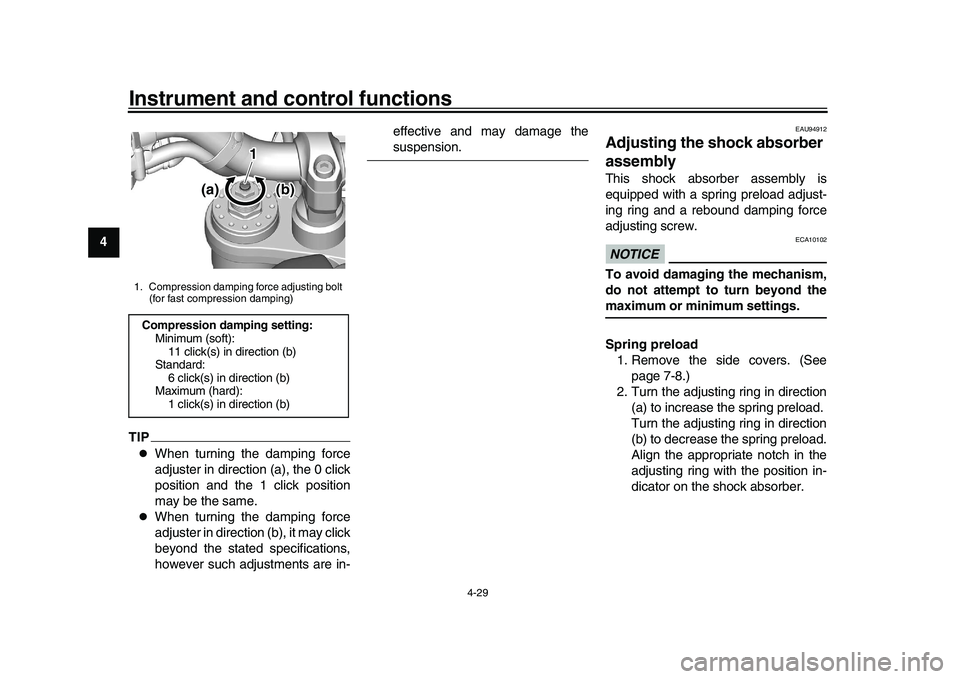
Instrument and control functions
4-29
1
2
34
5
6
7
8
9
10
11
12
13
TIP
When turning the damping force
adjuster in direction (a), the 0 click
position and the 1 click position
may be the same.
When turning the damping force
adjuster in direction (b), it may click
beyond the stated specifications,
however such adjustments are in- effective and may damage the
suspension.
EAU94912
Adjusting the shock absorber
assemblyThis shock absorber assembly is
equipped with a spring preload adjust-
ing ring and a rebound damping force
adjusting screw.NOTICE
ECA10102
To avoid damaging the mechanism,
do not attempt to turn beyond themaximum or minimum settings.
Spring preload
1. Remove the side covers. (See page 7-8.)
2. Turn the adjusting ring in direction (a) to increase the spring preload.
Turn the adjusting ring in direction
(b) to decrease the spring preload.
Align the appropriate notch in the
adjusting ring with the position in-
dicator on the shock absorber.
1. Compression damping force adjusting bolt (for fast compression damping)Compression damping setting:Minimum (soft):
11 click(s) in direction (b)
Standard: 6 click(s) in direction (b)
Maximum (hard): 1 click(s) in direction (b)
(b)
(a)
111
BEA-28199-E0.book 29 ページ 2021年12月1日 水曜日 午後7時8分
Page 53 of 114
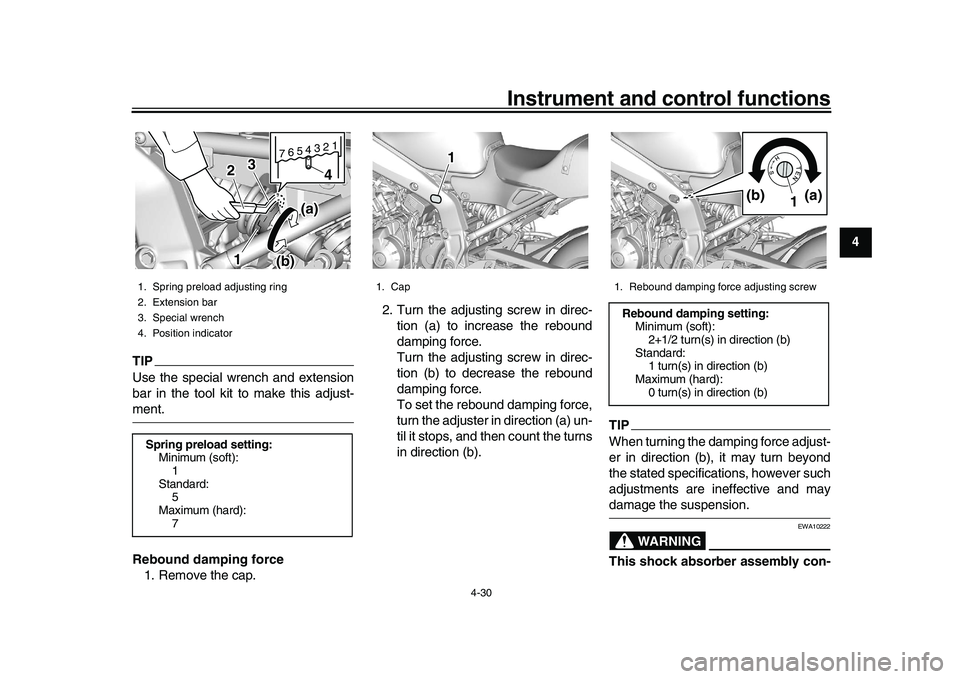
Instrument and control functions
4-30
1
2
345
6
7
8
9
10
11
12
13
TIPUse the special wrench and extension
bar in the tool kit to make this adjust-ment.
Rebound damping force 1. Remove the cap. 2. Turn the adjusting screw in direc-
tion (a) to increase the rebound
damping force.
Turn the adjusting screw in direc-
tion (b) to decrease the rebound
damping force.
To set the rebound damping force,
turn the adjuster in direction (a) un-
til it stops, and then count the turns
in direction (b).
TIPWhen turning the damping force adjust-
er in direction (b), it may turn beyond
the stated specifications, however such
adjustments are ineffective and maydamage the suspension.
WARNING
EWA10222
This shock absorber assembly con-
1. Spring preload adjusting ring
2. Extension bar
3. Special wrench
4. Position indicatorSpring preload setting:Minimum (soft):
1
Standard: 5
Maximum (hard): 7
7654321
4
1 1 1
2 2
3 3
(a) (a) (a)
(b) (b) (b)
1. Cap
111
1. Rebound damping force adjusting screwRebound damping setting: Minimum (soft):
2+1/2 turn(s) in direction (b)
Standard: 1 turn(s) in direction (b)
Maximum (hard): 0 turn(s) in direction (b)
1(a)
(b)
BEA-28199-E0.book 30 ページ 2021年12月1日 水曜日 午後7時8分
Page 54 of 114
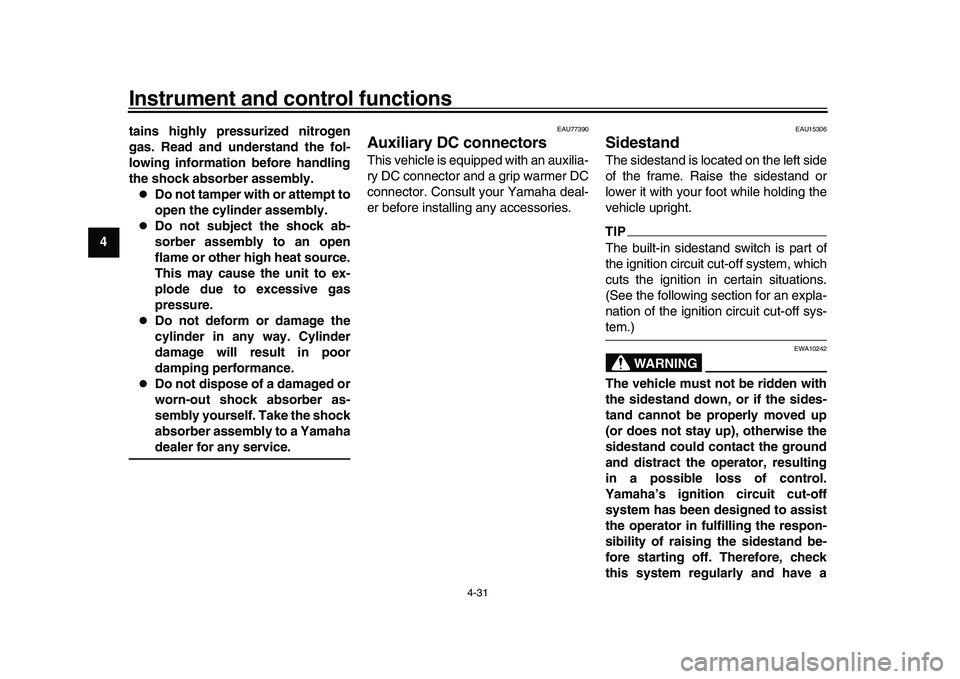
Instrument and control functions
4-31
1
2
34
5
6
7
8
9
10
11
12
13 tains highly pressurized nitrogen
gas. Read and understand the fol-
lowing information before handling
the shock absorber assembly.
Do not tamper with or attempt to
open the cylinder assembly.
Do not subject the shock ab-
sorber assembly to an open
flame or other high heat source.
This may cause the unit to ex-
plode due to excessive gas
pressure.
Do not deform or damage the
cylinder in any way. Cylinder
damage will result in poor
damping performance.
Do not dispose of a damaged or
worn-out shock absorber as-
sembly yourself. Take the shock
absorber assembly to a Yamahadealer for any service.
EAU77390
Auxiliary DC connectorsThis vehicle is equipped with an auxilia-
ry DC connector and a grip warmer DC
connector. Consult your Yamaha deal-
er before installing any accessories.
EAU15306
SidestandThe sidestand is located on the left side
of the frame. Raise the sidestand or
lower it with your foot while holding the
vehicle upright.TIPThe built-in sidestand switch is part of
the ignition circuit cu
t-off system, which
cuts the ignition in certain situations.
(See the following section for an expla-
nation of the ignition circuit cut-off sys-tem.)
WARNING
EWA10242
The vehicle must not be ridden with
the sidestand down, or if the sides-
tand cannot be properly moved up
(or does not stay up), otherwise the
sidestand could contact the ground
and distract the operator, resulting
in a possible loss of control.
Yamaha’s ignition circuit cut-off
system has been designed to assist
the operator in fulfilling the respon-
sibility of raising the sidestand be-
fore starting off. Therefore, check
this system regularly and have a
BEA-28199-E0.book 31 ページ 2021年12月1日 水曜日 午後7時8分
Page 55 of 114
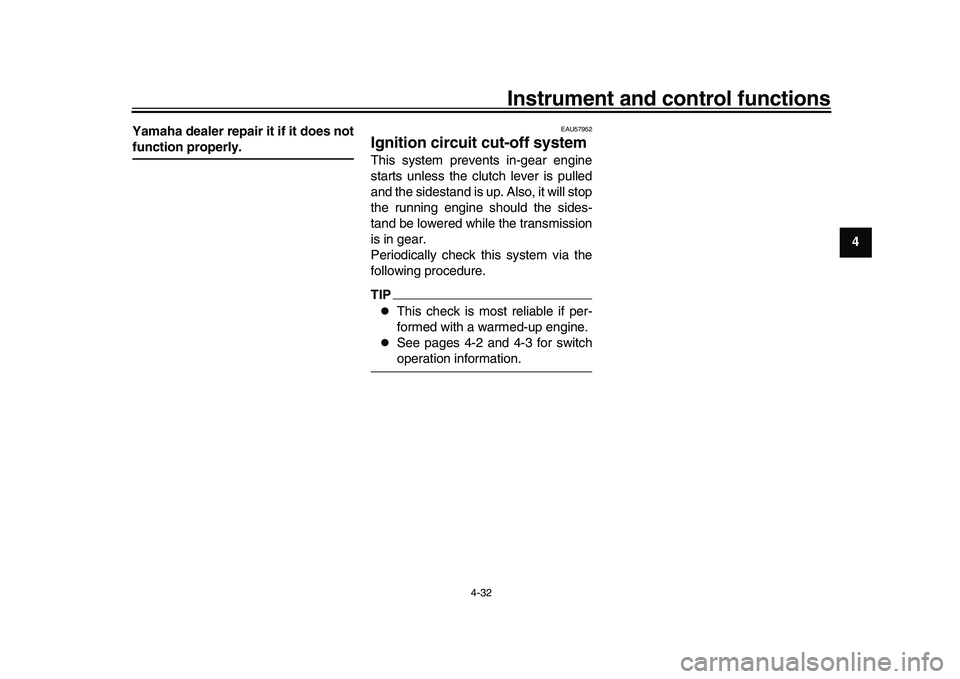
Instrument and control functions
4-32
1
2
345
6
7
8
9
10
11
12
13
Yamaha dealer repair it if it does not
function properly.
EAU57952
Ignition circuit cut-off systemThis system prevents in-gear engine
starts unless the clutch lever is pulled
and the sidestand is up. Also, it will stop
the running engine should the sides-
tand be lowered while the transmission
is in gear.
Periodically check this system via the
following procedure.TIP
This check is most reliable if per-
formed with a warmed-up engine.
See pages 4-2 and 4-3 for switchoperation information.
BEA-28199-E0.book 32 ページ 2021年12月1日 水曜日 午後7時8分
Page 56 of 114
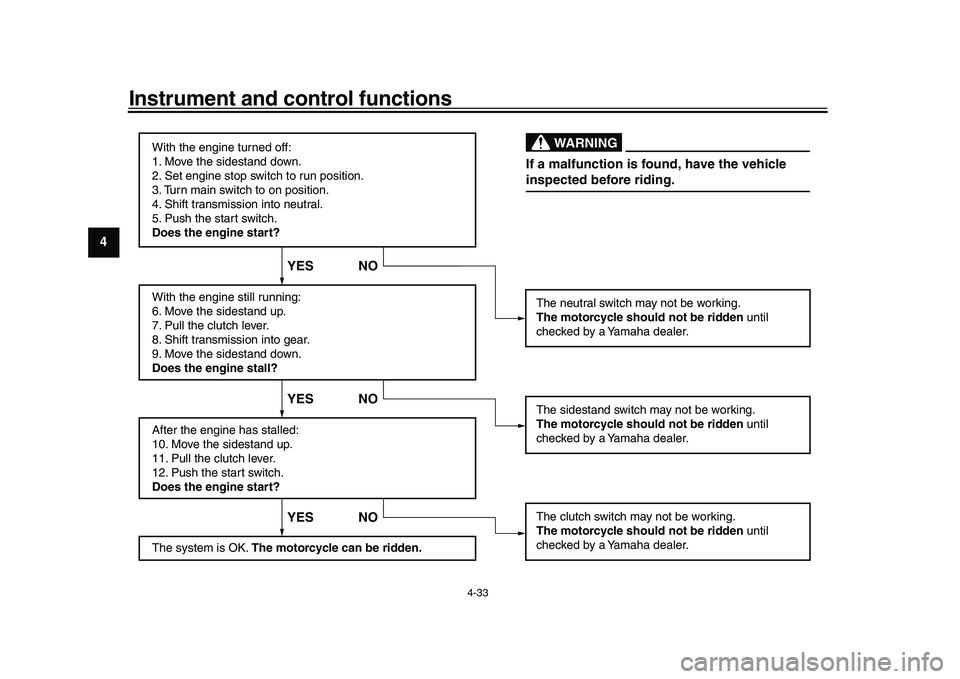
Instrument and control functions
4-33
1
2
34
5
6
7
8
9
10
11
12
13
With the engine turned off:
1. Move the sidestand down.
2. Set engine stop s witch to run position.
3. T urn m ain switch to on position.
4. Shift tr ansmission into neutr al.
5. Push the start switch.
Does the engine start?
With the engine still r unning:
6. Move the sidestand up.
7. Pull the clutch lever.
8. Shift tr ansmission into gear.
9. Move the sidestand down.
Does the engine stall?
After the engine has stalled:
10. Move the sidestand up.
11. P
ull the clutch lever.
12. Push the start switch.
Does the engine start?
The system is OK. The motorcycle can be ridden.
YES NO YES NO YES NO
The neutr al switch ma y not be working.
The motorcycle should not be ridden until
checked b y a Yamaha dealer.
The clutch s witch may not be working.
The motorcycle should not be ridden until
checked b y a Yamaha dealer.The sidestand s witch may not be working.
The motorcycle should not be ridden until
checked b y a Yamaha dealer.If a malfunction is found, have the vehicle
inspected before riding.
WARNING
BEA-28199-E0.book 33 ページ 2021年12月1日 水曜日 午後7時8分
Page 57 of 114
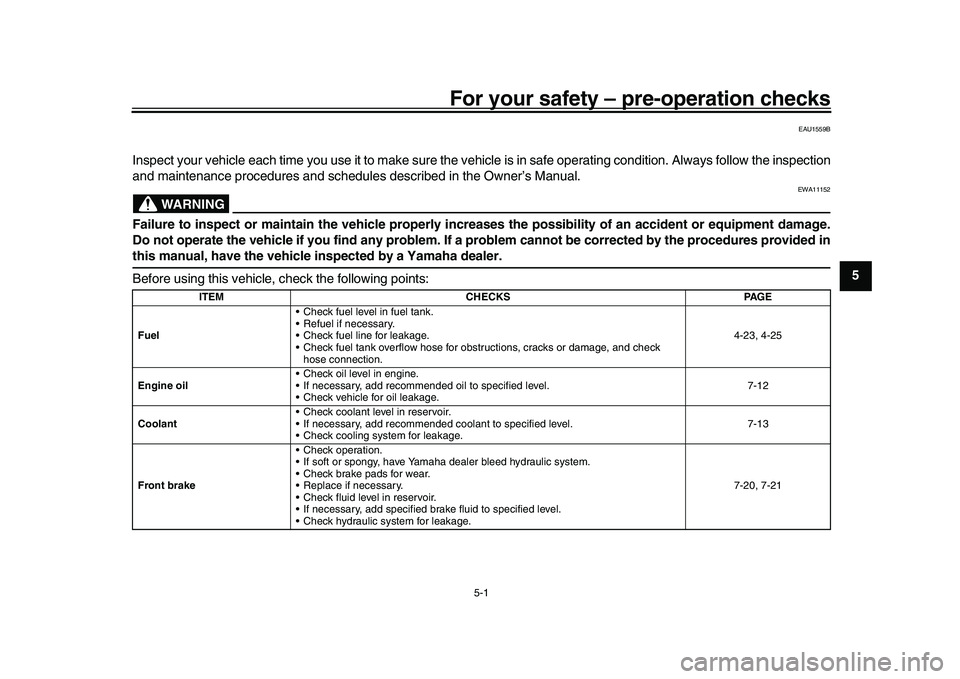
5-1
1
2
3
456
7
8
9
10
11
12
13
For your safety – pre-operation checks
EAU1559B
Inspect your vehicle each time you use it to make sure the vehicle is in safe operating condition. Always follow the inspection
and maintenance procedures and schedules described in the Owner’s Manual.
WARNING
EWA11152
Failure to inspect or maintain the vehicle properly increases the possibility of an accident or equipment damage.
Do not operate the vehicle if you find any problem. If a problem cannot be corrected by the procedures provided inthis manual, have the vehicle inspected by a Yamaha dealer.
Before using this vehicle, check the following points:
ITEM CHECKS PAGE
Fuel Check fuel level in fuel tank.
Refuel if necessary.
Check fuel line for leakage.
Check fuel tank overflow hose for obstr
uctions, cracks or damage, and check
hose connection. 4-23, 4-25
Engine oil Check oil level in engine.
If necessary, add recommended oil to specified level.
Check vehicle for oil leakage. 7-12
Coolant Check coolant level in reservoir.
If necessary, add recommended coolant to specified level.
Check cooling system for leakage. 7-13
Front brake Check operation.
If soft or spongy, have Yamaha dealer bleed hydraulic system.
Check brake pads for wear.
Replace if necessary.
Check fluid level in reservoir.
If necessary, add specified brake fluid to specified level.
Check hydraulic system for leakage. 7-20, 7-21
BEA-28199-E0.book 1 ページ 2021年12月1日 水曜日 午後7時8分
Page 58 of 114
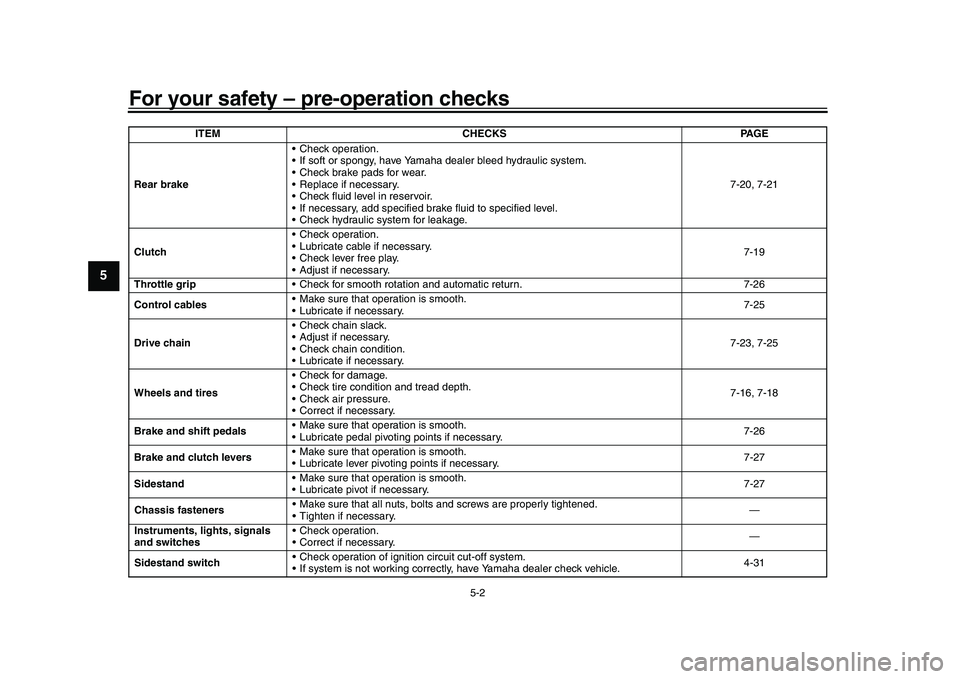
For your safety – pre-operation checks
5-2
1
2
3
45
6
7
8
9
10
11
12
13
Rear brake Check operation.
If soft or spongy, have Yamaha dealer bleed hydraulic system.
Check brake pads for wear.
Replace if necessary.
Check fluid level in reservoir.
If necessary, add specified brake fluid to specified level.
Check hydraulic system for leakage. 7-20, 7-21
Clutch Check operation.
Lubricate cable if necessary.
Check lever free play.
Adjust if necessary. 7-19
Throttle grip Check for smooth rotation and automatic return. 7-26
Control cables Make sure that operation is smooth.
Lubricate if necessary. 7-25
Drive chain Check chain slack.
Adjust if necessary.
Check chain condition.
Lubricate if necessary. 7-23, 7-25
Wheels and tires Check for damage.
Check tire condition and tread depth.
Check air pressure.
Correct if necessary. 7-16, 7-18
Brake and shift pedals Make sure that operation is smooth.
Lubricate pedal pivoting points if necessary. 7-26
Brake and clutch levers Make sure that operation is smooth.
Lubricate lever pivoting points if necessary. 7-27
Sidestand Make sure that operation is smooth.
Lubricate pivot if necessary. 7-27
Chassis fasteners Make sure that all nuts, bolts
and screws are properly tightened.
Tighten if necessary. —
Instruments, lights, signals
and switches Check operation.
Correct if necessary.
—
Sidestand switch Check operation of ignition circuit cut-off system.
If system is not working correctly, have Yamaha dealer check vehicle. 4-31
ITEM CHECKS PAGE
BEA-28199-E0.book 2 ページ 2021年12月1日 水曜日 午後7時8分
Page 59 of 114
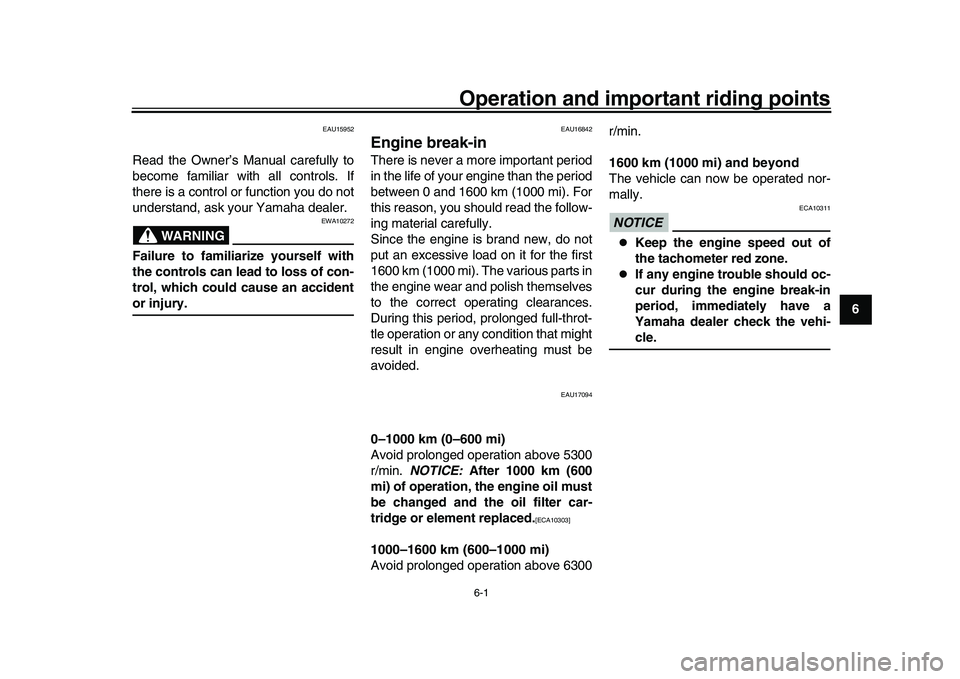
6-1
1
2
3
4
567
8
9
10
11
12
13
Operation and important riding points
EAU15952
Read the Owner’s Manual carefully to
become familiar with all controls. If
there is a control or function you do not
understand, ask your Yamaha dealer.
WARNING
EWA10272
Failure to familiarize yourself with
the controls can lead to loss of con-
trol, which could cause an accidentor injury.
EAU16842
Engine break-inThere is never a more important period
in the life of your engine than the period
between 0 and 1600 km (1000 mi). For
this reason, you should read the follow-
ing material carefully.
Since the engine is brand new, do not
put an excessive load on it for the first
1600 km (1000 mi). The various parts in
the engine wear and polish themselves
to the correct operating clearances.
During this period, prolonged full-throt-
tle operation or any condition that might
result in engine overheating must be
avoided.
EAU17094
0–1000 km (0–600 mi)
Avoid prolonged operation above 5300
r/min. NOTICE: After 1000 km (600
mi) of operation, the engine oil must
be changed and the oil filter car-
tridge or element replaced.
[ECA10303]
1000–1600 km (600–1000 mi)
Avoid prolonged operation above 6300 r/min.
1600 km (1000 mi) and beyond
The vehicle can now be operated nor-
mally.
NOTICE
ECA10311
Keep the engine speed out of
the tachometer red zone.
If any engine trouble should oc-
cur during the engine break-in
period, immediately have a
Yamaha dealer check the vehi-cle.
BEA-28199-E0.book 1 ページ 2021年12月1日 水曜日 午後7時8分
Page 60 of 114
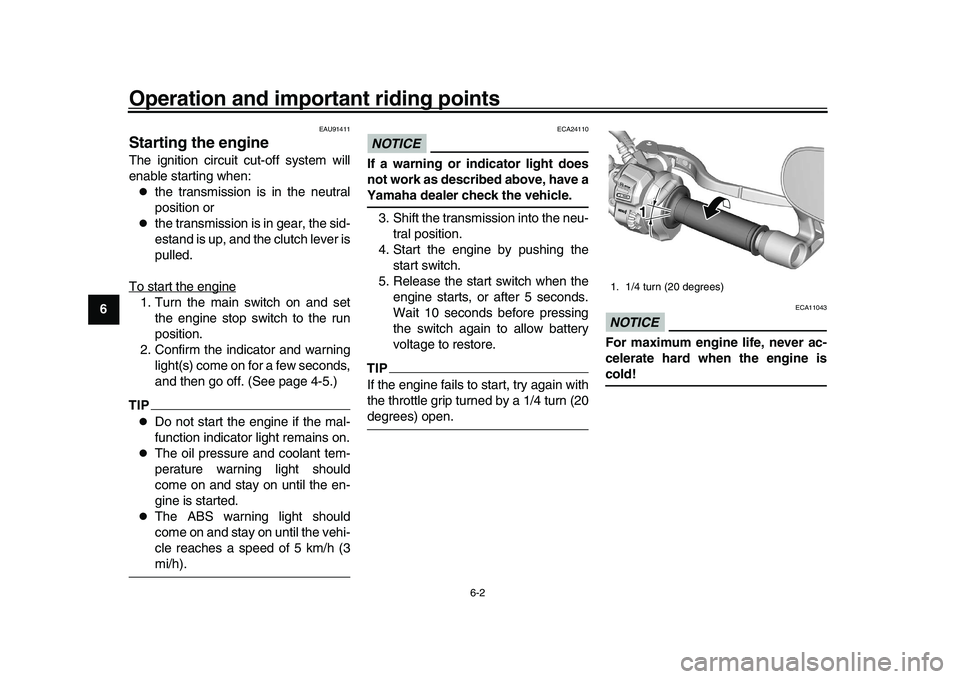
Operation and important riding points
6-2
1
2
3
4
56
7
8
9
10
11
12
13
EAU91411
Starting the engineThe ignition circuit cut-off system will
enable starting when:
the transmission is in the neutral
position or
the transmission is in gear, the sid-
estand is up, and the clutch lever is
pulled.
To start the engine
1. Turn the main switch on and set the engine stop switch to the run
position.
2. Confirm the indicator and warning light(s) come on for a few seconds,
and then go off. (See page 4-5.)TIP
Do not start the engine if the mal-
function indicator light remains on.
The oil pressure and coolant tem-
perature warning light should
come on and stay on until the en-
gine is started.
The ABS warning light should
come on and stay on until the vehi-
cle reaches a speed of 5 km/h (3mi/h).
NOTICE
ECA24110
If a warning or indicator light does
not work as described above, have aYamaha dealer check the vehicle.
3. Shift the transmission into the neu- tral position.
4. Start the engine by pushing the start switch.
5. Release the start switch when the engine starts, or after 5 seconds.
Wait 10 seconds before pressing
the switch again to allow battery
voltage to restore.TIPIf the engine fails to start, try again with
the throttle grip turned by a 1/4 turn (20degrees) open.
NOTICE
ECA11043
For maximum engine life, never ac-
celerate hard when the engine iscold!1. 1/4 turn (20 degrees)
111
BEA-28199-E0.book 2 ページ 2021年12月1日 水曜日 午後7時8分